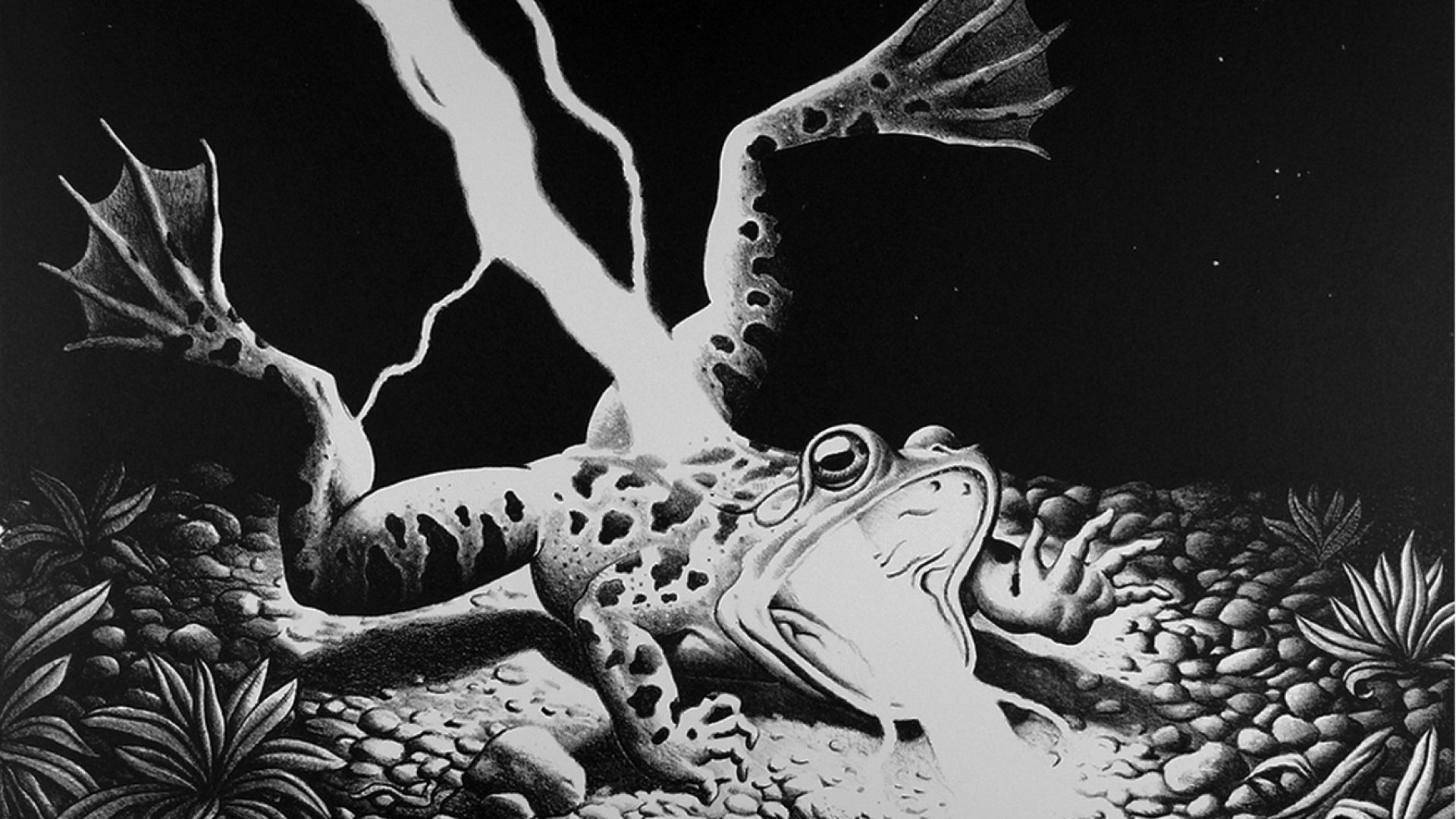This ‘Unarcheology Radio’ mix presents a selection of Frogs from all over the world mixed together with ancient Japanese temple bells, dating from 8th and 17th century.
Frogs and toads produce a rich variety of sounds, calls, and songs during their courtship and mating rituals. The callers, usually males, make stereotyped sounds in order to advertise their location, their mating readiness and their willingness to defend their territory; listeners respond to the calls by return calling, by approach, and by going silent. Each species has a distinct call, though even among the same species, different dialects are found in different regions. Although humans cannot detect the differences in dialects, frogs distinguish between regional dialects. For example, male bullfrogs can recognize the calls of their direct territorial neighbors. By ignoring the calls of these neighbors, they save energy, and only vocalize aggressively in response to an intruder’s call. In this way, calls establish territories, but they also attract females.
Depending on the region that the frog lives in, certain times of the year are better for breeding than others, and frogs may live away from the best breeding grounds when it is not the species’ mating season. During the breeding season, they congregate to the best breeding site and compete for call time and recognition.
Bonshō (梵鐘, Buddhist bells), also known as tsurigane (釣り鐘, hanging bells) or ōgane (大鐘, great bells) are large bells found in Buddhist temples throughout Japan, used to summon the monks to prayer and to demarcate periods of time. Rather than containing a clapper, bonshō are struck from the outside, using either a handheld mallet or a beam suspended on ropes.
Image: Jim Woodring “Inspiration”
00:01 Shomyoji Bonsho (1301), Kanasawa
00:01 Alytes cisternasii
00:37 Alytes muletensis
00:54 Kenchoji Temple (1255), Kamakura
01:14 Litoria rothii
02:20 Alytes obstetricans
02:27 Neobatrachus pelobatoides
03:00 Australian Whistling Frogs
03:07 Onoejinja Temple, Kamogawa
03:10 Bombina variegata
05:05 Heleioporus inornatus
05:28 Bombina bombina
06:15 Todaiji Temple, Daibutsu (1239), Nara
07:38 Pelobates fuscus
08:00 Breviceps sopranus
08:28 Pelobates fuscus
08:39 Afrixalus aureus
08:47 Pelodytes punctatus
09:16 Kanzeonji Temple (7th C.), Dazaifu (Kyushu)
10:39 Xenopus laevis
11:30 Myoshini Temple (AD 698), Kyoto, Hanazono (Ukyo)
11:59 Rana temporaria
12:39 Rana iberica
12:51 Rana pyrenaica
12:56 Amietia angolensis
13:18 Neobatrachus sutor
13:25 Artroleptella landdrosia
13:36 Rana ridibunda
13:53 Rana temporaria
14:08 Bufotes viridis
14:25 Chion-in Temple (1633), Kyoto, Higashiyama
14:25 Geocrinia leai
15:06 Rana dalmatina
15:20 Rana lessonae
15:32 Rana perezi
15:48 Rana arvalis
15:54 Shofukuji Temple, Fukuoka (Kyushu)
15:57 Crinia glauerti
16:02 Schismaderma carens
16:19 Rana arvalis
16:45 Pelophylax kl. esculentus
16:51 Notaden nichollsi
17:20 Rana sqhiperica
17:22 Rana arvalis
17:32 Breviceps macrops
17:35 Rana dalmatina
18:15 Rana iberica
18:50 frog’s symphony in Buckeye Creek Farm Cherokee GA
19:09 Rana latastei
19:45 Breviceps macrops
20:45 Rana perezi
20:59 Isehara (near Yokohama)
21:19 Rana kl. esculenta
21:21 Ranoidea splendida
21:35 Arthroleptella villiersi
22:23 Rana ridibunda
22:30 Discoglossus pictus
22:43 Hyla meridionalis
23:36 Discoglossus sardus
24:00 Bombina bombina
24:08 Kasaokidera temple
24:40 Discoglossus galganoi
25:17 Lithobates virgatipes
25:29 Engakuji Temple (1301), Kamakura
25:32 Bufo bufo
26:09 Shofukuji temple
26:45 Rana epirotica
27:15 Phrynobatrachus acridoides
27:23 Epidalea calamita
27:40 Rana catesbeina
28:09 Rana epirotica
28:35 Heleioporus eyrei
29:13 Rana bergeri
29:20 Bufo viridis
29:26 Kasaokidera Temple, Kyoto
29:50 Pelophylax kl. grafi
30:00 Rana perezi
30:30 Afrixalus fornasini
30:36 Frogs in Casalbono, Romagna
30:50 Enjoji Temple, Otsu (near Kyoto)
